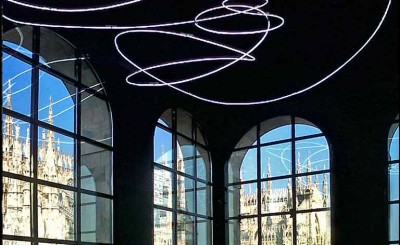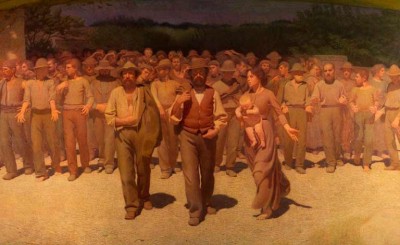In the heart of Milan: 5 places to visit in Piazza Duomo!
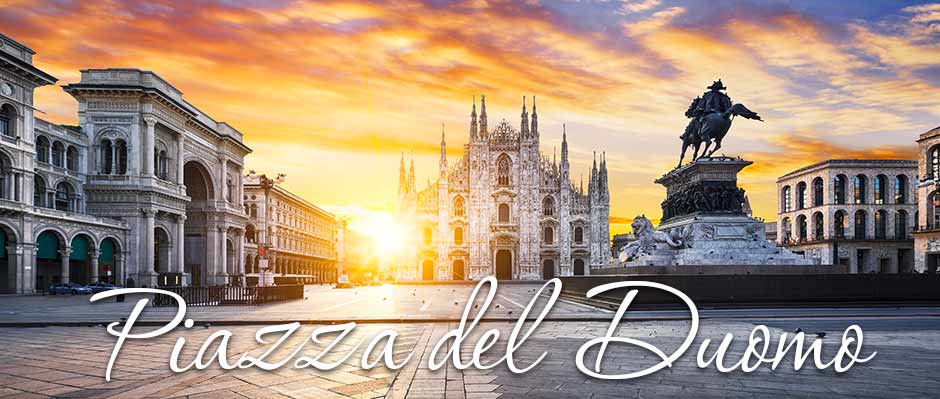
Milan boasts an inestimable historical, artistic and architectural heritage. And all this is contained in Piazza del Duomo: the symbol of the city of Milan!
Exactly in the centre of Milan we find a lively and dynamic square that offers many possibilities: to get up on the roof of the Cathedral to see the city view, to go shopping in exclusive boutiques under a spectacular iron-glass vaults, to visit a splendid museum, to admire the magnificent architectures by which is surrounded.
Every circle, obviously, must have a centre. Milan never lost its circular shape and has undoubtedly its centre in Piazza del Duomo!
It’s a geometric and geographic but also human and ideal centre, characterised by interesting things to do.
Duomo’s parvis, the sacred space in front of the Cathedral, is very wide and simple to walk around and photograph. Here are the 5 things to do and visit in Piazza del Duomo in Milan!
1 - The Piazza del Duomo
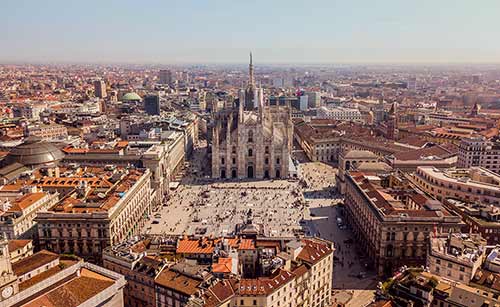
Piazza del Duomo is the central and most important square in Milan. Piazza Duomo is the commercial and geometrical centre of Milan, meeting point for everything and together with the wonderful Galleria Vittorio Emanuele along its side, is the iconic place per excellence of Milan.
The piazza del Duomo in Milan, with its rectangular shape is one of the biggest squares of Italy: it is composed by Duomo’s Majestic Gothic façade, by Vittorio Emanuele II’s statue and by a series of architectures surrounding it, dated back to different periods.
Piazza Duomo was projected by Giuseppe Mengoni and was opened to the public in 1865. However, since the ancient times it has been city’s keystone: when the Celts invaded Milan, sure enough, the square didn’t exist yet, but the place was used to administrate religious and civil power.
Also Romans used the place to venerate their Gods, constructing a temple dedicated to Minerva. When pagan Gods was substituted by the Christian God, there appeared the Santa Tecla Church and the Santa Maria Maggiore Basilica, later destructed in order to make place for the actual Cattedrale dell'Arcidiocesi di Milano, the Basilica Cattedrale Metropolitana della Natività della Beata Vergine Maria.
Today in the square have place some of Milan’s most important monuments: the Cathedral, Palazzo Reale, the Galleria di Vittorio Emanuele II and the Palazzo Arcivescovile.
Moreover, the place is surrounded by porticoes that lead into the Gallery and connect the Palazzo dell’Arengario, location of the Museo del Novecento. The hall at the last floor of the Museo del Novecento has a lighting installation, and is probably the best place to take pictures of Piazza Duomo, from where people seem little figures of a futurist painting.
At the centre of the square there is the equestrian statue of Vittorio Emanuele II. It was realised by the sculptor Ercole Rosa commissioned by Umberto I in memory of his father, in the 1870s, but it was positioned in the centre of the square just in 1896. Ercole Rosa died during the work, finished by the Barzaghi brothers, under the direction of the sculptor Ettore Ferrari.
2 - Duomo di Milano, a Gothic Cathedral
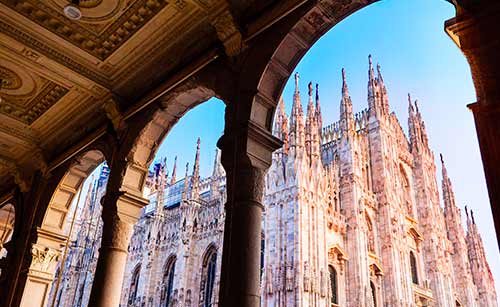
What could be more representative of Milan if not its Cathedral? The Church, dedicated to Santa Maria Nascente, wanted by Gian Galeazzo Visconti, is the symbol of the city, as well as one of the first things to visit as soon as you arrive in Milan.
Milan’s Cathedral is one of the biggest Gothic Churches ever built, it appears in our pictures as an icon of its pentagonal façade and presents itself as a whole.
But this compactness is an appearance, probably tank to the marvellous and total Candoglia marble cladding, coming from a wonderful cave at the Lago Maggiore.
The Duomo di Milano, at the contrary of what we could think, was realised in more than 500 years and changed its style at least 3 times: the “triangle” façade that we all know, for example, is only a couple of centuries old.
The first stone was laid by a duke of the Visconti dynasty in 1386, while the last bronze door was made 50 years ago. Milan Cathedral’s story remains endless, because an ancient building as this tends irresistibly to get old: during the last 60 years, the continuous passing of the underground trains put Church’s stability at risk and it had to be subjected to long radical structural work.
Furthermore, the Cathedral is periodically cleaned in order to return white, as the great French novelist Stendhal, in love with Milan, saw it in the 19th century. The same happens to the terraces and the staircases that bring you up quite until the Madunina: they are periodically cleaned and polished by professionals of a specialised cleaning company.
Today, in order to enter in the Cathedral as a tourist you need to queue and pass under the metal detector security control. From inside the Cathedral of Milan you can go under the Church porch and visit the underground rests, surprisingly wide, of the churches that preceded the Cathedral in its late Roman and Medieval history.
Piazza del Duomo could be, in conclusion, visited from above and also from below: you will not forget it easily!
3 - The Madonnina dorata and the terraces of the Duomo di Milano
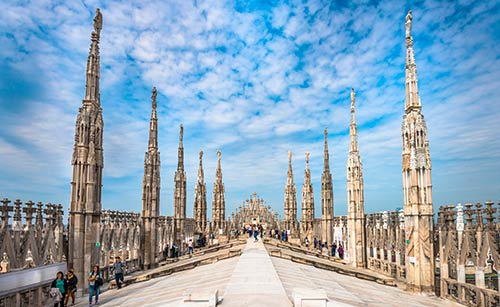
The terraces of the Duomo di Milano has always been fascinating all tourists and inhabitants of Milan, passing through Piazza del Duomo.
Visiting, touching, admiring and taking pictures of them is a unique emotion that you need to experience at least once in your life! It’s possible to enter using the 17th-century lift or going up on the 180 steep and narrow steps!
From the Duomo di Milano’s terraces is possible to see the highest peaks of the city: the Cadorna Skyscraper, the Castello Sforzesco di Milano, the Torre Branca and the RAI antenna, the Torre Velasca, the Porta Garibaldi towers, the new Palazzo Lombardia, the Piazza della Repubblica’ skyscrapers, the Pirellone, the Breda tower and the Centro Svizzero.
Looking at Piazza Duomo from above, recognising the newest Milan with its skyscrapers, or being amazed by the mushroom shape of the near Torre Velasca are priceless experiences!
It’s all an getting up and down through steeples and statues that initially appear so far, but are actually there, near to you, under the protective eye of the Madonnina dorata (the “Golden Madonna”) that reveals itself colossal when you get nearer.
The Madonnina, symbol of the city and protectress of the Milanese, was realised in copper sheets, embossed and gilded, sustained by a stainless steel skeleton. It was erected on the biggest steeples of the Duomo di Milano at the end of the 1774.
The terraces of the Duomo di Milano are really an unique place in the world!
4 - Galleria Vittorio Emanuele II
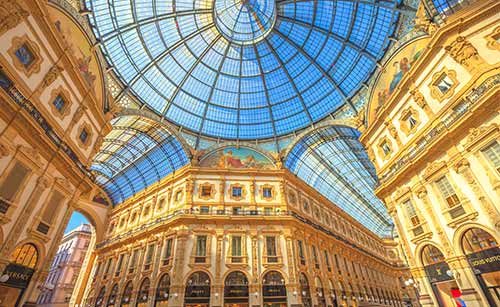
The famous Galleria Vittorio Emanuele II, connecting Piazza Duomo to Piazza della Scala, was built in the 19th century when Milan envying the other European capitals and wanted to be equal to them. Today it is considered the Milan’s salon with its well-known shops and famous cafés.
When you go inside the Galleria Vittorio Emanuele II, on the northern side of Piazza Duomo, your Smartphone’s memory gets full of pictures, taken in rapid sequence.
Shop windows, many-coloured floors, glass walls, big high mosaics on the central Octagon, the bull quite at the centre of the pavement and, always useful, the tourist information office on the Piazza della Scala side.
One of Milan’s traditions is tied to the Galleria and tourists don’t miss to follow it with amusement: to be lucky, you need to turn right round for 3 times with you right heel pointed on bull’s private parts painted on Octagon’s floor in the mosaic of city’s coat of arms.
In the Galleria Vittorio Emanuele II you’ll find also many prestigious brand shops: some people consider it the natural continuation of the quadrilatero della moda.
When it was thought to built this luxury passage along the Cathedral, Milan was still under the Austro-Hungarian Empire and the building risked to be called “Galleria Francesco Giuseppe”. Since the 1860s, when it was actually realised, it was called as the first Italia King Vittorio Emanuele II.
In occasion of the Expo 2015, the Gallery was totally restructured and supplied by the opening of the new Feltrinelli in Foscolo street and by the Mercato del Duomo.
Furthermore it is possible to stroll on the top of the Gallery roofs thanks to the initiative Highline Galleria. And last but not least, for the lovers of Italian Award-Winning Cooking, remember that the Chef Carlo Cracco, one of the Italian most beloved chefs in the world, opened just in the Galleria his new restaurant.
5 - The Museo del Novecento
The Museo del Novecento (Museum of the 20th century), inside the Palazzo dell’Arengario in piazza del Duomo di Milano, hosts a collection of more than 4.000 extraordinary works of Italian art from the 20th century.
The museum, inaugurated to the public on the 6th of December 2010, was born with the intention to spread art knowledge of the 20th century and to allow a better and wider vision of the collections in Milan.
Along the exhibition activity, the museum is also involved with the conservation work, study and promoting of the cultural and artistic Italian heritage of the 20th century, with the purpose to captivate a wide and cross public.
The restoration project in 2010 allowed to optimise spaces’ use and to transform the building in one of the privileged places for culture in Milano.
The large flight of stairs inside the structure is probably the most significant architectural work of the museum: a functional element connecting different floors of the tower, from the underground level to the suggestive terrace over the Cathedral. Go up at least until the Quarto Stato: it’s worth it!
There are many jewels of the crown in the collection. Above all, the Quarto Stato di Giuseppe Pellizza da Volpedo, to whom is dedicated a hall along the helicoidal flight with free entrance; then the present to the Avanguardie Internazionali, with paintings from the beginning of the century by Pablo Picasso, Georges Braque, Paul Klee, Vasilij Kandinskij and Amedeo Modigliani.
The entire last floor of the Arengario is dedicated to Lucio Fontana. The Fontana hall has been projected as an environmental immersive work to host the big roof from the 1956, coming from the Hotel del Golfo in Isola d’Elba, the Neon, property of the Fondazione Fontana and the “Space concepts” of the 1950s. Observing the Duomo di Milano from the hall’s wide glass walls, surrounded by the great Fontana work is simply amazing.
Toward the heart of Milan with Vip Limousine!
Our Call Centre is operating on a 24-hour basis and will be able to offer you a Luxury car rental with driver in Milan service for any kind of activity you have to conduct here: we’ll be at your disposal for organising and logistic manners, for transfers from and to Milan’s airports (Malpensa, Linate and Bergamo Orio al Serio), for transfers from and to the Train Station, for tours of the city of Milan or for the beloved shopping tours in Milan.
Milan offers an inestimable historic, artistic and architectural heritage. It is also Italy’s undisputed fashion capital, there is no better place in the world to dedicate yourself to the shopping! Vip Limousine offers different types of shopping-tours, well planned and organised in order to take full advantage of timing and transfers without stress.
Book a Vip Limousine luxury car with driver for the entire duration of your stay in Milan: your itinerary will be customised day by day based on your specific needs!
For any further information or quote requests please refer to our contact page.

